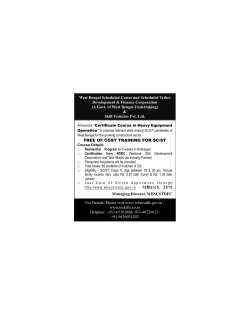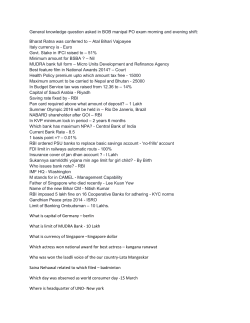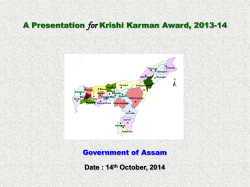
Status of India`s Exploited Marine Fishery
Mar. Fish. Infor. Serv., T & E Ser., No. 221, 2014 3 Status of India's Exploited Marine Fishery Resources in 2013 Sathianandan, T. V., Jayasankar, J., Somy Kuriakose, Mini, K. G., Grinson George, Syamala Karthireddy, Vinay Kumar Vase, Srinivasan, J., Ramani, K ., Pugazhendi, D., Seynudeen, M. B., George, K. P., Lata Khambadkar, Sindhu, K. Augustine and Manjeesh, R. Central Marine Fisheries Research Institute, Kochi The Central Marine Fisheries Research Institute started estimation of marine fish landings for the peninsular coast of India since its inception in 1947, based on a stratified multistage random sampling technique. This continues to date, and provides knowledge-base for many research, planning and policy initiatives in the marine fisheries sector. For the estimation of landings, stratification is done over space and time. Over space, the entire coast line is divided into 75 non-overlapping geographical regions, designated as fishing zones for which the estimates are made for each month. These zones consist of 1,511 marine fish lading centres where landings take place throughout the year by different types of fishing crafts. The estimate of all India annual marine fish landings for the year 2013 is 3.78 million tonnes (t) which has witnessed a dip of 1.56 lakh t compared to the all-time high landings of 3.94 million t in 2012. Spatial Patterns of Landings The north-east coast comprising the maritime states of West Bengal and Odisha contributed 10% to the all India marine fish production in 2013. The landings from this region were about 3.86 lakh t and 4% lower than the last year. West Bengal accounted for 68 % of the landings and the remaining (32 %) was from Odisha. The contribution from south-east region comprising the maritime states of Andhra Pradesh, Tamil Nadu and Puducherry was 10.2 lakh t, with Tamil Nadu being the major contributor (67 %) in this region. The south-west 4 region was the most productive and the largest contributor to the total marine fish landings of the country. Marine fish production in this region during the year 2013 was estimated as 12.13 lakh t, contributing 32% to the national landings. Among the different states in this region, the maximum contribution was from Kerala, 6.71 lakh t (55%), followed by Karnataka 4.37 lakh t (36%) and the rest 1.04 lakh t (9%) from Goa. Compared to the estimate of 2012, a decrease of about 1.74 lakh t in landings was noticed in the south-west region. The contribution from north-west region comprising Maharashtra, Gujarat and UT Daman & Diu is 30.7% of the all India landings, with Gujarat leading among all maritime states with an estimate of 7.17 lakh t. Sectoral Composition in Landings The marine fishery resources from the Indian seas are harvested using more than 35 different types of craft-gear combinations. Among the different gears operated along the Indian coast, trawlnets accounted for nearly half of the landings followed by seinenets (20%), gillnets (13%) and dolnets (8.5%). Among the three different categories of crafts used namely mechanized, motorized and non-motorized, the contribution from mechanized sector was 79.5%, whereas contribution from motorized sector was 18.6% and that from artisanal sector was 1.9%. Mechanized sector continued to dominate the production scenario in all the regions with a major share of 20.15 lakh t from the west coast. In the north-west region, 92% of the landings were accounted by mechanized sector whereas in all other regions its contribution was between 70 - 78%. Motorized sector contributed 7 lakh t, with the Mar. Fish. Infor. Serv., T & E Ser., No. 221, 2014 south-east and south-west regions accounting for more than 5.1 lakh t. In the north-east region, it accounted for 27% of the total landings while in the north-west region it formed only 7%. Non-motorized sector as a whole contributed 1.9% with the southeast region being the major contributor. Resource Profile From the coastal waters of India, about 670 species were landed during 2013. Of these, 110 species, belonging to 10 major resource groups comprised 70% of the total catch. The estimated landings of major species/groups contributing to marine capture fisheries production in 2013 is given in Table 1.The contribution to the total marine fish landings by pelagic and demersal fishes are about 56% and 26% respectively, while the crustaceans accounted for 13% and molluscs accounted for less than 5%. The contribution by pelagic finfishes in 2013 was 21.23 lakh t. The pelagic fishery was mainly supported by oil sardine with a share of 28%. Mackerel landings witnessed an increase of about 30,000 t from previous year. Ribbonfishes, Stolephorus spp., carangids, tuna, seerfishes and Bombayduck were the other major components of the pelagic finfish production.The landings of the demersal resources showed decrease of 1.4 lakh t which is mainly due to the reduction of about 30,000t in landings of threadfin breams. lizardfishes, croakers, sole, flatfishes, pomfrets, silverbellies and catfishes which are the major demersal finfish resources. In the case of crustacean resources, a decline of about 55,000 t was noticed in the landings of penaeid prawns, while an increase of 48,000 t was noticed in the landings of non-penaeid prawns. A marginal decline was noticed in the landings of lobsters and crabs too. The landings of the molluscan resources also witnessed a decrease though there was an increase in the landings of squids during the year. Landings of oil sardine, the major single species resource, after having peaked at about 7.2 lakh t in 2012, showed a decline with an estimate of 5.95 lakh t in 2013. About two-third of the oil sardine landings were from south-west region and the remaining from south-east and north-west regions. Mar. Fish. Infor. Serv., T & E Ser., No. 221, 2014 5 Kerala, the major contributor to the oil sardine production (41.5%) witnessed a decline of about 1.5 lakh t. Tamil Nadu, second largest contributor accounting for 30% of the oil sardine production witnessed an increase of about 0.75 lakh t during 2013 while Karnataka slipped to the third position with a decrease of 21,000 t. Table 1. Estimated landings of major resources Resources 2012 2013 Oil sardine 720270 595392 Ribbon fishes 234766 252179 Non-penaeid prawns 164951 213474 Indian mackerel 170410 199880 Penaeid prawns 252300 196942 Cephalopods 190408 189426 Threadfin breams 211618 182541 Croakers 215824 177395 Other sardines 149022 159580 91449 127935 Bombayduck 114378 124509 Silverbellies 140843 121117 Scads Components of marine fish landings in India during 2013 Penaeid and non-penaeid prawns together contributed over 4.10 lakh t, forming 11% of the total landings. Non-penaeid prawns formed a little over 52% with north-west region as the area of highest occurrence. Compared to 2012, this resource showed an increase of about 0.5 lakh t, while a reverse trend was noticed in the case of penaeid prawns. The major contributing states were Gujarat, Kerala, Maharashtra, Andhra Pradesh and Tamil Nadu. In 2013, ribbonfishes production reached 2.52 lakh t and accounted for about 7% of total marine fish production in the country. Compared to 2012, an increase of 17,000 t was noticed in the landings. North-west coast alone produced 1.52 lakh t of ribbonfishes with Gujarat contributing the maximum (88%). It was mainly exploited by trawlers with peak landings during September and October. Indian mackerel formed another major fishery resource among pelagic finfishes with a production of 2 lakh t. It was exploited all along the Indian coast with bulk of the landings from the south-west and southeast regions. Nearly 50% of the landings came from Karnataka and Kerala, the other major contributor being Andhra Pradesh (17%). Cephalopods are an important component of the Indian marine fisheries mainly due to their commercial value.The contribution by cephalopod resources showed a marginal decline, owing to the decreased landings of cuttlefishes and octopus. However an increase of 7,700 t was noticed in the squid landings during 2013. The west-coast accounted for 85% of production with Gujarat, Kerala and Karnataka as the top producers. Likewise, most of the threadfin breams catch was netted from the west coast of India. These formed an important demersal fishery resource with estimated landing of 1.83 lakh t in 2013, accounting for 4.8% of the total marine fish landings. About 12% of the trawl landings constituted by this group. Bombayduck was an abundant resource along the north-west coast of India, contributing about 5% of all India marine fish landings. The landings have been estimated at 1.1 lakh t along the north-west (88%) and north-east (12%) coasts of India. Along the north-west coast, landings in Gujarat are showing a stabilized trend with seasonal variations, whereas in Maharashtra the landings show wide fluctuations. Tunas which are one of the most valuable resources of the Indian marine fisheries recorded a production of 0.85 lakh t in 2013, being slightly higher than that in 2012. Euthynnus affinis and Thunnus tonggol together accounted for more than 61% of the tuna catches. The other major resources Mar. Fish. Infor. Serv., T & E Ser., No. 221, 2014 6 contributing to the landings were croakers (4.7%), other sardines (4.2%), scads (3.4%) and silverbellies (3.2%). Seasonal Sketch Fishing is carried out throughout the year along the Indian coast except during the fishing ban period for mechanized vessels imposed by the Government of India. In 2013, the fishing ban was for 45 days during June 15 to July 31 along the west coast and April 15 to May 31 along the east coast, except for Goa where the fishing ban extended for 60 days. During 2013, October - December period was the most productive season (34%) followed by January - March (27%). Compared to 2012, except for the period July-September there was not much variation in the quarterwise percentage contributions. However there was a decline of about 81,500 t during this period in 2013 as compared to 2012. A rare occurrence of Blackfringe bigeye Pristigenys refulgens (Valenciennes, 1862), off Malabar coast Pavithran, P. P., Manojkumar, P. P. and Ramachandran, N. P. Calicut Research Centre of CMFRI, Kozhikode The family Priacanthidae commonly inhabit rocky areas and reefs, although a few are known to inhabit open waters. Priacanthids are typically colored bright red, but some have patterns in silver, dusky brown, or black. They have unusually large eyes, suited to their habitat in deeper waters. Pristigenys is one of the genera in Priacanthidae in family and comprises of 3 species. On 15th October, 2013, one male Pristigenys refulgens specimen measuring 254 mm in total length and weighing 437 g (Fig.1) was caught by a trawler at a depth of 120-140 m off Kozhikode (11°14.600 N 74°56.424 E). Morphological characters of the species were recorded. Morphometric characters of Pristigenys refulgens landed at Kozhikode Morphometric characters Fig. 1. Blackfringe bigeye Pristigenys refulgens landed at Kozhikode Measurement (mm) Total length 254 Standard length 207 Head length 92 Body depth 101 Pre-orbital length 36 Post-orbital length 22 Eye diameter 34 Pre-dorsal length 84 Dorsal fin base length 103
© Copyright 2025








